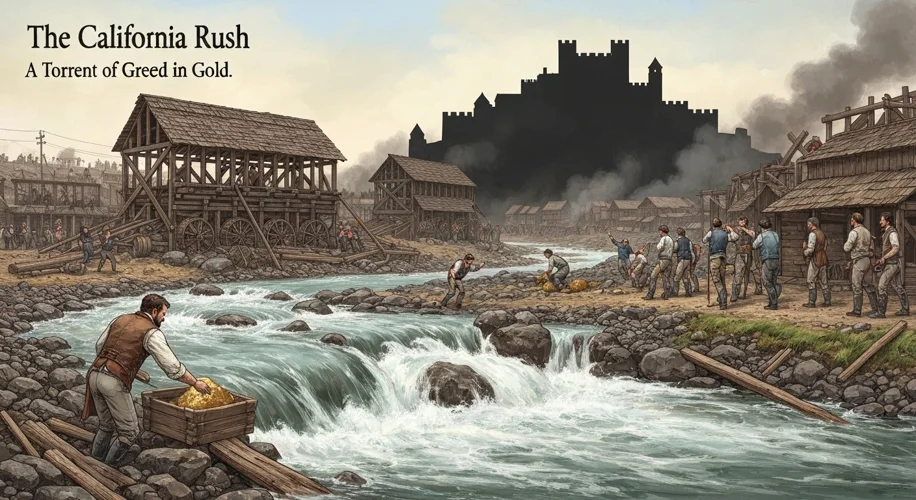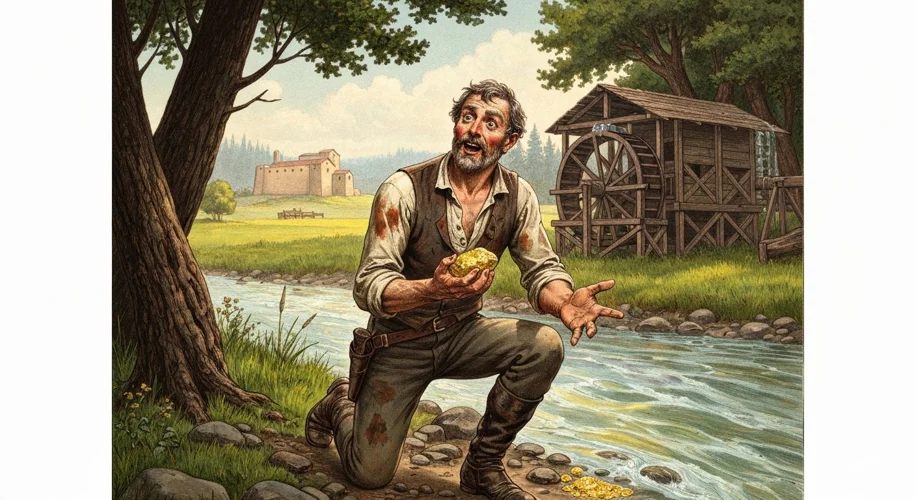The air in Northern California in January 1848 was crisp, carrying the scent of pine and damp earth. Few could have predicted that this tranquil landscape would soon be transformed into a churning cauldron of human ambition, greed, and desperation. The spark? A tiny, glinting nugget of gold, discovered not by a seasoned prospector, but by a humble carpenter named James W. Marshall.
Marshall was overseeing the construction of a sawmill for John Sutter, a Swiss immigrant who held vast land grants from the Mexican government, near Coloma on the American River. While inspecting the millrace, a glint caught his eye. He stooped, his heart pounding, and picked up a small, heavy, yellow object. It was gold.

The news, however, was initially met with skepticism. Sutter, fearing the disruption it would bring to his agricultural empire, tried to suppress the discovery. But secrets, especially those involving the promise of instant wealth, have a way of escaping. The whispers grew to shouts, and by the spring of 1848, the trickle of curious individuals turned into a flood.
The culture of California at the time was a unique blend of Californios (Mexican Californians), Native American tribes, and a small but growing number of American settlers. The Mexican-American War had just concluded, and California was officially ceded to the United States. The Treaty of Guadalupe Hidalgo was signed in February 1848, ironically, around the same time Marshall was unearthing California’s golden secret. Yet, the official transfer of power was slow, creating a legal and administrative vacuum that the ensuing gold fever would obliterate.
The gold rush wasn’t just a Californian phenomenon; it was a global event. News of the discovery spread like wildfire, carried by ships across the Pacific and overland by word-of-mouth. Men from every corner of the globe – the United States, Europe, China, Australia, and South America – were captivated by the dream of striking it rich. They became known as the “Forty-Niners,” a testament to the year the true exodus began.
Imagine the scene: a rough-and-tumble, chaotic influx of humanity descending upon the land. They came by sea, landing in San Francisco, a small settlement that would soon explode into a bustling metropolis. They came overland, enduring arduous journeys across treacherous mountain passes and vast deserts, their wagons laden with hope and their hearts filled with a feverish anticipation.
San Francisco transformed from a sleepy port town into a cacophony of boomtown life. Tents and hastily erected shacks sprang up like mushrooms. Fortunes were made and lost in a matter of days. Prices for basic necessities skyrocketed. A simple meal could cost a week’s wages, and a room in a crowded boarding house was a luxury.
The miners themselves were a diverse lot. There were the seasoned prospectors, armed with experience and a keen eye for likely spots. Then there were the “greenhorns,” often city dwellers or farmers, ill-equipped and naive, quickly falling prey to scams or the harsh realities of mining.
Life in the goldfields was brutal. Long hours were spent toiling in rivers and on hillsides, sifting through mud and gravel. The work was back-breaking, and the rewards were often meager. Many miners toiled for months, only to find a few ounces of gold, barely enough to cover their expenses. Disease, accidents, and sheer exhaustion were constant companions. Violence, fueled by alcohol and desperation, was also a grim feature of camp life.
The impact of the Gold Rush on California was profound and irreversible. The Native American population, already devastated by disease and displacement, was further decimated by the encroachment of miners, who often viewed them as obstacles or even threats. Their lands were seized, their resources plundered, and many were killed or driven away.
The influx of people led to rapid territorial expansion and, crucially, accelerated California’s path to statehood. In 1850, just two years after the initial discovery, California was admitted to the Union as a free state, a significant development in the escalating tensions over slavery in the United States.
Economically, the gold rush was a double-edged sword. While it brought immense wealth to some and stimulated American economic growth, it also created immense social upheaval and environmental degradation. The landscape was scarred by mining operations, rivers were dammed and diverted, and mercury, used in the extraction process, poisoned the water and soil.
The California Gold Rush was more than just a quest for precious metal; it was a defining moment in American history. It was a catalyst for westward expansion, a crucible for diverse cultures, and a stark reminder of both the allure of fortune and the human cost of ambition. The echoes of those desperate, hopeful, and often tragic years still resonate in the Golden State today, a testament to the day a humble carpenter found a glint of gold and changed the world forever.

